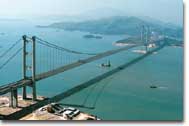 INTRODUCTION INTRODUCTION
The Tsing Ma Bridge, which spans 1377m across the busy Ma Wan Channel, is the second longest bridge in the world after the Humber Bridge in Britain. However, it is the longest bridge that carries both motorway and
railway.
There are five major components in the construction of the Tsing Ma
Bridge:
1. Foundations and the construction of the bridge tower
-- one tower located on Tsing Yi side and the other on a man-made island 120 m from the coast of Ma Wan Island. Both towers are 206 m above sea level and founded on relatively shallow bedrock. The towers are two-legged with trusses at intervals, in the form of portal beam design. The legs were constructed with high-strength concrete of 100 MPa strength, using a slipform system in a continuous
operation.
2. Anchorages --
the pulling forces in the main suspension cables is taken up by large gravity anchorages located at both ends of the bridge. They are massive concrete structures deeply seated on bedrock on the landside of Tsing Yi and Ma Wan island. The total weight of concrete used in the two anchorages is about 300,000
tonnes.
3. Main cables --
The cables were constructed by an aerial spinning process. The process involved drawing wires from a constant-tension supply, and pulling loops of these wires from one anchorage to the other, passing a 500-tonne cast-iron saddle on top of each bridge tower seating the cable. A total of 70,000 galvanised wires of 5.38 mm diameter were placed and adjusted to form the 1.1 m diameter main
cable.
4. Suspended deck
-- The steelwork for the deck structure was fabricated in Britain and Japan. After delivery, they were further processed and assembled in Dongguan of China into standard deck modules. A total of 96 modules, each 18 m long and about 480 tonnes in weight, were prepared. These deck modules were brought to the site by specially designed barges and raised into the deck position by a pair of strand jack gantries that could manoeuvre along the main
cable.
5. Approach span on Tsing Yi side
-- similar in form and cross-section to the suspended deck, but the approach span was supported on piers instead of cable-support. The first span was assembled on the ground and raised into position using strand jacks. Further erection then proceeded in cantilever in smaller sections, using derrick cranes stationed on the deck level. An expansion joint which allowed for a maximum thermal movement of 850 mm was also provided and located inside the approach span
section.
The Tsing Ma Bridge was designed to carry two three-lane carriageways on the upper deck and two railway tracks on the lower deck. There are also two sheltered single-lane carriageways on the lower deck for maintenance access and as backup for traffic during typhoons when wind speed is still within acceptable limits. The construction cost of Tsing Ma bridge is $7.14 billion and the actual completion time was 57
months.
main contractor
Anglo Japanese Construction
Trafalgar House Construction (Asia) Ltd
Constain Civil Engineering Ltd
Mitsui & Co Ltd
joint venture |

 INTRODUCTION
INTRODUCTION